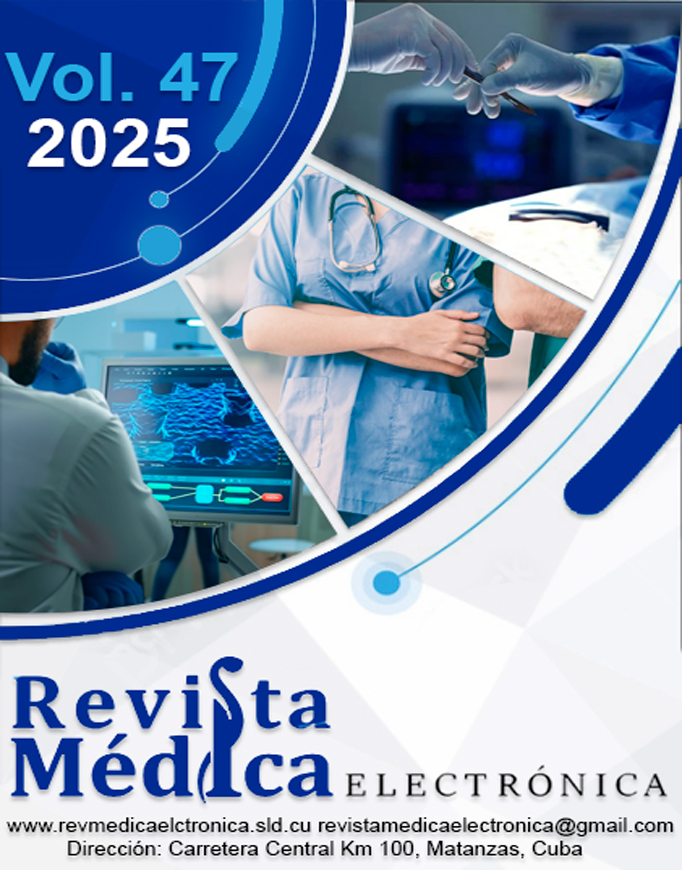Morbimortalidad en pacientes relaparotomizados en unidades de atención al grave
Palabras clave:
pacientes relaparotomizados; relaparotomía; relaparotomía a demanda; índice predictivo de relaparotomíaResumen
Introducción: La relaparotomía es una reintervención planificada, o no, que se lleva a cabo durante el período postoperatorio de la laparotomía, principalmente por complicaciones de la cirugía abdominal primaria, asociada a mayor morbimortalidad.
Objetivo: Caracterizar la morbimortalidad en los pacientes relaparotomizados de las unidades de atención al grave.
Métodos: Se realizó un estudio observacional, descriptivo, retrospectivo, de corte transversal, en las unidades de terapia intensiva e intermedia del Hospital Universitario Clínico Quirúrgico Comandante Faustino Pérez Hernández, de Matanzas, durante el 1 de enero de 2020 al 31 de diciembre de 2022. La muestra estuvo conformada por 23 pacientes que requirieron relaparotomía. Se declararon variables sociodemográficas y clínicas.
Resultados: Predominaron los pacientes fallecidos, representados por el grupo de 60 años y más. Prevalecieron la relaparotomía a demanda, los pacientes con tres o más relaparotomías, las relaparotomías entre 72 horas y hasta siete días, la sepsis intrabdominal como causa de ingreso en la unidad y de relaparotomía, y se relacionaron con el mayor número de defunciones. Todos los pacientes que desarrollaron shock séptico fallecieron. Sobresalió el grupo con índice de peritonitis de Mannheim de 30 y más, y el índice predictivo de relaparotomía entre 11 y 14, relacionados con una mortalidad superior.
Conclusiones: La aplicación temprana del índice de peritonitis de Mannheim y del índice predictivo de relaparotomía son útiles para decidir una relaparotomía y disminuir la morbimortalidad asociada. La programación de una relaparotomía desde una cirugía inicial, constituye una piedra angular para una evolución satisfactoria.
Descargas
Citas
Nivelo Zumba JE, Vera Macías JJ, Cabezas Dillon CA, et al. Relaparotomía tras cirugía abdominal de emergencia, análisis de causas y factores de riesgo. Journal of American Health [Internet]. 2022 [citado 28/09/2024];5(2). Disponible en: https://jah-journal.com/index.php/jah/article/view/136
Guerra Macías I, Castañeda Urdaneta F, Cutié Taquechel G. Perfil clínico, quirúrgico y epidemiológico de pacientes reintervenidos. Rev Cubana Cir [Internet]. 2021 [citado 25/10/2024];60(4). Disponible en: http://scielo.sld.cu/scielo.php?script=sci_arttext&pid=S0034-74932021000400008&lng=es
Ferreira e Pereira EB, Santos de Souza JH, de Araújo Sousa TD, et al. Ocurrencia de laparotomía de eme rgencia y factores de riesgo asociados a la relaparotomía. RUE [Internet]. 2022 [citado 27/09/2024];17(1):e2022v17n1a3. Disponible en: https://rue.fenf.edu.uy/index.php/rue/article/view/333
Cruz Jordán V, Miñan Arana F. Factores de Riesgo Asociados a las Relaparotomías no Programadas en Pacientes Tratados Quirúrgicamente por el Servicio de Cirugía General del Hospital de Especialidades de Guayaquil “Dr. Abel Gilbert Pontón”. Revista Especialidades HAGP [Internet]. 2023 [citado 27/09/2024];1. Disponible en: https://revista.hospitalguayaquil.gob.ec:9092/index.php/revista/article/download/6/21/38
Abebe K, Geremew B, Lemmu B, et al. Indications and Outcome of Patients who had Re-Laparotomy: Two Years’ Experience from a Teaching Hospital in a Developing Nation. Ethiop J Health Sci. 2020;30(5). DOI: 10.4314/ejhs.v30i5.13.
Ugumba CS, Kasong MK, Kaoma Cabala VdP, et al. Study of Prognostic Risk Factors for Relaparotomy in University Hospitals of LUBUMBASHI: Analysis of Biological and Terapéutico Clinical Criteria. Act Scie Medic Sci [Internet]. 2022 [citado 27/09/2024];6(7):21-7. Disponible en: https://actascientific.com/ASMS/pdf/ASMS-06-1305.pdf
Soler Morejón CD, Tamargo Barbeito TO, Pérez Mayo JC, et al. Validez de tres procedimientos para la predicción de reoperación en cirugía abdominal: estudio de cohorte. Rev Cubana Med Milit [Internet]. 2020 [citado 27/09/2024];49(4):e0200760. Disponible en: https://revmedmilitar.sld.cu/index.php/mil/article/view/760
Awad S, El-Rahman AIA, Abbas A, et al. The assessment of perioperative risk factors of anastomotic leakage after intestinal surgeries; a prospective study. BMC Surg. 2021;21(29). DOI: 10.1186/s12893-020-01044-8.
Calas Rodríguez A, Pérez Assef H, Araujo Pradere LJ. Peritonitis terciaria como reto para los cuidados intensivos. Rev Cubana Cir [Internet]. 2021 [citado 27/09/2024];60(4). Disponible en: http://scielo.sld.cu/scielo.php?script=sci_arttext&pid=S0034-74932021000400010&lng=es
Amentie E, Beyene B, Sisay M, et al. Magnitude of early relaparotomy and its outcome among patients who underwent laparotomy in a tertiary hospital in Eastern Ethiopia: a cross- sectional study. BMC Surg. 2024;24(51). DOI: 10.1186/s12893-024-02338-x.
Zala JN, Badami K, Jivani S, et al. Observational clinical study of indications and outcome of re-exploration laparotomy in 50 patients. Int Surg J. 2022;9(11):1830-4. DOI: 10.18203/2349-2902.isj20222937.
Swallow AY, Akoko LO, Lema LE. Patient’s characteristics, management practices and outcome of re-laparotomies in a tertiary hospital in Tanzania. Heliyon. 2020;6(7). DOI: 10.1016/j.heliyon.2020.e04295.
Yucra Callo RS. Factores asociados a relaparotomía en el servicio de Cirugía General del Hospital Antonio Lorena del Cusco, 2015 – 2023 [tesis en Internet]. Cusco: Universidad Nacional de San Antonio Abad del Cusco; 2024 [citado 27/09/2024]. Disponible en: http://repositorio.unsaac.edu.pe/handle/20.500.12918/9089
García Gutiérrez AI. Exceso de base en pacientes con cirugía abdominal mayor, como factor predictivo de complicaciones [tesis en Internet]. Carabobo: Universidad de Carabobo [Internet]; 2015 [citado 19/10/2024]. Disponible en: http://mriuc.bc.uc.edu.ve/handle/123456789/2822
La Rosa Armero Y, Rodríguez Fernández Z, Matos Tamayo ME. El dilema de las reintervenciones quirúrgicas. Rev Cubana Cir [Internet]. 2019 [citado 27/09/2024];57(4). Disponible en: https://revcirugia.sld.cu/index.php/cir/article/view/708
Quintero Infante A, Díaz Mayo J, Laurencio Vargas Y, et al. Pacientes con cirugía abdominal. Rev Cubaana Med Int Emerg [Internet]. 2018 [citado 25/10/2024];17(4). Disponible en: https://revmie.sld.cu/index.php/mie/article/view/426
Encalada JF, Campelos P, Delgado C, et al. Reintervenciones en una Unidad de Cuidados Intensivos de Cirugía Cardiovascular. Cir Esp. 2016;94(4):227-31. DOI: 10.1016/j.ciresp.2015.07.004.
Espinoza R, Espinoza JP. Calidad en cirugía: hacia una mejor comprensión de las complicaciones quirúrgicas. Rev Méd Chile [Internet]. 2016 [citado 25/10/2024];144(6):752-7. Disponible en: http://www.scielo.cl/scielo.php?script=sci_arttext&pid=S0034-98872016000600010&lng=es
Cintra Pérez D, Cintra Brooks D, Ramírez Robert D, et al. Técnica de abdomen abierto en el servicio de Cirugía del Hospital General Docente “Dr. Agostinho Neto” de Guantánamo. Rev Inf Cient [Internet]. 2014 [citado 25/10/2024];86(4). Disponible en: https://revinfcientifica.sld.cu/index.php/ric/article/view/1053
Hernández Ruiz A, Vinent Llorente JA, Delgado Fernández RI, et al. Factores que influyen en la mortalidad en los pacientes graves con cirugía abdominal. Rev Cubana Cir [Internet]. 2014 [citado 25/10/2024];53(2):134-44. Disponible en: http://scielo.sld.cu/scielo.php?script=sci_arttext&pid=S0034-74932014000200003&lng=es
González Yovera JG, Díaz Saraza PD. Características epidemiológicas, clínicas y quirúrgicas de pacientes sometidos a relaparotomía, en el Hospital Base Almanzor Aguinaga Asenjo de Chiclayo 2014-1016 [tesis en Internet]. Lambayeque: Universidad Nacional Pedro Ruiz Gallo; 2017 [citado 25/10/2024]. Disponible en: https://repositorio.unprg.edu.pe/handle/20.500.12893/926
Soria-Aledo V, Angel-Garcia D, Martinez-Nicolas I, et al. Desarrollo y estudio piloto de un conjunto esencial de indicadores para los servicios de cirugía general. Cir Esp. 2016;94(9):502-10. DOI: 10.1016/j.ciresp.2016.06.009.
Cordero Escobar I. Factores predictores de sepsis posoperatoria en pacientes intervenidos de cirugía de urgencia. Rev Cubana Med Int Emerg [Internet]. 2023 [citado 27/09/2024];22(4). Disponible en: https://revmie.sld.cu/index.php/mie/article/view/992
Publicado
Cómo citar
Número
Sección
Licencia
Derechos de autor 2025 Revista Médica Electrónica

Esta obra está bajo una licencia internacional Creative Commons Atribución-NoComercial 4.0.
La misma permite:
• Copiar y redistribuir el material publicado en cualquier medio o formato.
• Adaptar el contenido.
Esto se realizará bajo los siguientes términos:
• Atribuir los créditos de los autores e indicar si se realizaron cambios, en cuyo caso debe ser de forma razonable.
• Uso no comercial.
• Reconocer la revista donde se publica.
Se mantienen los derechos de autoría de cada artículo, sin restricciones.







